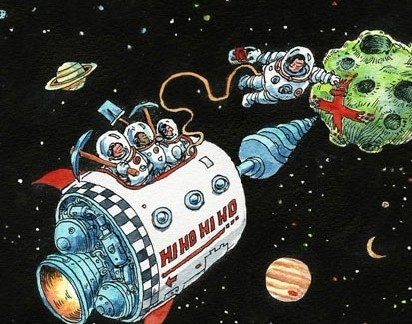Mining asteroids
Going platinum
Mining metals from asteroids seems a bonkers idea. But could it work?
CAN reality trump art? That was the question hovering over the launch on April 24th, at the Museum of Flight in Seattle, of a plan by a firm called Planetary Resources to mine metals from asteroids and bring them back to Earth.

It sounds like the plot of a film by James Cameron—and, appropriately, Mr Cameron is indeed one of the company’s backers. The team behind the firm, however, claim they are not joking. The company’s founders are Peter Diamandis, instigator of the X Prize, awarded in 2004 to Paul Allen and Burt Rutan for the first private space flight, and Eric Anderson, another of whose companies, Space Adventures, has already shot seven tourists into orbit. Larry Page and Eric Schmidt, respectively the chief executive and the chairman of Google, are also involved. So, too, is Charles Symonyi, the engineer who oversaw the creation of Microsoft’s Office software (and who has been into space twice courtesy of Mr Anderson’s firm). With a cast-list like that, it is at least polite to take them seriously.
As pies in the sky go, some asteroids do look pretty tasty. A lot are unconsolidated piles of rubble left over from the beginning of the solar system. Many, though, are pieces of small planets that bashed into each other over the past few billion years. These, in particular, will be high on Planetary Resources’ shopping list because the planet-forming processes of mineral-melting and subsequent stratification into core, mantle and crust will have sorted their contents in ways that can concentrate valuable materials into exploitable ores. On Earth, for example, platinum and its allied elements, though rare at the surface, are reckoned more common in the planet’s metal-rich core. The same was probably true of the planets shattered to make asteroids. Indeed, the discovery of a layer of iridium-rich rock (iridium being one of platinum’s relatives) was the first sign geologists found of the asteroid impact that is believed to have killed the dinosaurs.
Most asteroids dwell between the orbits of Mars and Jupiter. But enough of them, known as near-Earth asteroids, or NEAs, come within interplanetary spitting distance of humanity for it to be worth investigating them as sources of minerals—if, of course, that can be done economically.
First catch your hare
The first thing is to locate a likely prospect. At the moment, about 9,000 NEAs are known, most of them courtesy of ground-based programmes looking for bodies that might one day hit Earth. That catalogue is a good start, but Planetary Resources plans to go further. In 2014 it intends to launch, at a cost of a few million dollars, a set of small space telescopes whose purpose will be to seek out asteroids which are easy to get to and whose orbits return them to the vicinity of Earth often enough for the accumulated spoils of a mining operation to be downloaded at frequent intervals.
That bit should not be too difficult. But the next phase will be tougher. In just over a decade, when a set of suitable targets has been identified, the firm plans to send a second wave of spacecraft out to take a closer look at what has been found. This is a significantly bigger challenge than getting a few telescopes into orbit. It is still, though, conceivable using existing technology. It is after this that the handwaving really starts.
Broadly, there are two ways to get the goodies back to Earth. The first is to attempt to mine a large NEA in its existing orbit, dropping off a payload every time it passes by. That is the reason for the search for asteroids with appropriate orbits. This approach will, however, require intelligent robots which can work by themselves for years, digging and processing the desirable material. The other way of doing things is for the company to retrieve smaller asteroids, put them into orbit around Earth or the moon, and then dissect them at its leisure. But that limits the value of the haul and risks a catastrophic impact if something goes wrong while the asteroid is being manoeuvred.
Either way, the expense involved promises to be out of this world. A recent feasibility study for the Keck Institute for Space Studies reckoned that the retrieval of a single 500-tonne asteroid to the moon would cost more than $2.5 billion. Earlier research suggested that, to have any chance of success, an asteroid-mining venture would need to be capitalised to the tune of $100 billion. Moreover, a host of new technologies will be required, including more-powerful solar panels, electric-ion engines, extraterrestrial mining equipment and robotic refineries.
All of which can, no doubt, be done if enough money and ingenuity are applied to the project. But the real doubt over this sort of enterprise is not the supply, but the demand. Platinum, iridium and the rest are expensive precisely because they are rare. Make them common, by digging them out of the heart of a shattered planet, and they will become cheap. The most important members of the team, then, may not be the entrepreneurs and venture capitalists who put up the drive and the money, nor the engineers who build the hardware that makes it all possible, but the economists who try to work out the effect on the price of platinum when a mountain of the stuff arrives from outer space.











